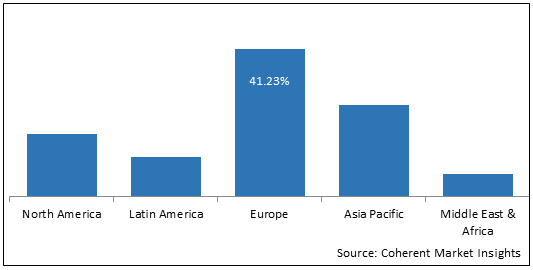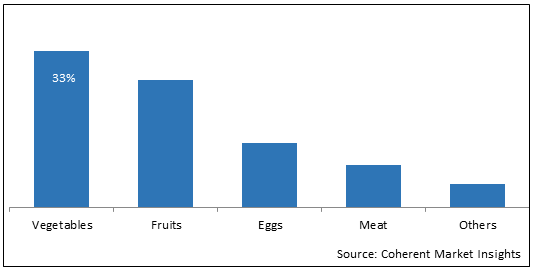Reusable plastic containers (RPC) has become increasingly popular in the transportation of food and beverages around the world. Totes, boxes, bulk containers, sleeves, and other reusable plastic containers are all examples of reusable plastic containers. Reusable plastic containers are rapidly displacing paper corrugated boxes as a means of transporting foods, beverages, and other items. End users benefit from RPCs because they are recyclable, durable (weather resistant), safe, and reusable. These benefits are expected to drive the reusable plastic container market growth in the coming years. Due to its cost-effectiveness, non-reactivity with food, beverages, and cosmetics, it is light weight, and hassle-free process cycle reusable plastic has emerged as a viable alternative to packaging materials such as glass, paper, wood, metal, and others. According to the European Commission (EC), Germany has the largest cosmetics market, worth US $ 13.39 Bn, followed by France (US $ 11.90 Bn), the United Kingdom (US $ 11.44 Bn), and Italy (US $ 10.87 Bn) (US $ 10.07 Bn).
The reusable plastic containers market was valued at US$ 255.77 Mn in 2020 and is expected to reach US$ 489.3 Mn by 2028, exhibiting a CAGR of 9.5% during the forecast period (2021-2028).
Drivers:
The e-commerce industry's expansion is driving the market revenue growth. Marketed packaged goods must be protected from being destroyed or tampered, which will drive demand for reusable packaging containers in the near future. Reusable packaging is also more durable and robust, providing better protection for the products contained within. It helps to reduce the need for resources to dispose of unsellable products, as well as manufacture and ship replacements, by minimizing transit damage.
The shape of the pack, which is optimized to save cargo space without compromising the protection of the product packed inside, is one of the key factors driving the reusable packaging industry. Companies are investing in research and development in order to create innovative and high-performing packaging solutions. Returnable packaging systems save money on transportation because they are lightweight and stackable, which means there is no wasted space.
Figure 1. Global Reusable Plastic Containers Market Revenue Share (%), By Region, 2020

To learn more about this report, Download Free Sample
Among regions, Europe held a dominant position in the reusable plastic containers market in 2020, accounting for 41.23% market revenue share, followed by Asia Pacific and North America. According to The Future of the EU Automotive Sector report, October 2021, Due to automotive industry has been booming in the Central and Eastern European (CEE) region, major premium car manufactures in this region demand for automotive fluids is very high. The largest automotive suppliers are represented in the region, such as, Porsche, Mercedes-Benz, Audi, Skoda, Dacia etc. Hence the demand of reusable plastic containers packaging for automotive is growing in the forecast period.
Market Restraints
Storage space requirement and potential loss of material is restraining the reusable plastic containers market growth. The issue becomes where to store the returnable packaging once it is received. Because of the design and strength, storing empty reusable packaging takes up more space than one-time packaging options.
Reusable Plastic Containers Market Report Coverage
| Report Coverage | Details | ||
|---|---|---|---|
| Base Year: | 2020 | Market Size in 2020: | US$ 255.77 Mn |
| Historical Data for: | 2017 to 2019 | Forecast Period: | 2021 to 2028 |
| Forecast Period 2021 to 2028 CAGR: | 9.5% | 2028 Value Projection: | US$ 489.3 Mn |
| Geographies covered: |
|
||
| Segments covered: |
|
||
| Companies covered: |
Menasha Corporation, IFCO, Schoeller Allibert, Myers Industries, DS Smith, Rehrig Pacific Company, Nefab Group, IPL Plastics, Vetropack Holding, and Schütz GmbH & Co. KGaA. |
||
| Growth Drivers: |
|
||
| Restraints & Challenges: |
|
||
Uncover macros and micros vetted on 75+ parameters: Get instant access to report
Market Trends
Cube shaped packaging in logistics chains is one of the growing trends in the returnable packaging industry. According to packaging strategy, for instance, To achieve sufficient load factors, a producer must fill, store, and handle packages, while a transport provider aims for efficient loading and unloading as well as volume and weight-efficient packaging. Then, warehouse and store operators want to efficiently pick, stack, store, and replenish packaging, and the packages should be simple to open, use, empty, and dispose of for customers. Cylindrical steel and plastic drums, on the other hand, have the advantage of being easy to use and handle by a single person without the need for any mechanical handling equipment. Large companies also use rectangular-shaped Intermediate Bulk Containers (IBCs) because they allow containers to be packed closer together with less void space in between. The demand for returnable packaging systems is expected to rise in the coming years as a result of these advantages.
Figure 2. Reusable Plastic Containers Market Revenue Share (%), By Application Type, 2020

To learn more about this report, Download Free Sample
Among application, the vegetables segment held a dominant position in the reusable plastic containers market in 2020, accounting for 33 % of market share. Reusable plastic containers provide superior product protection and temperature management in the transport of vegetables. For long distance travel, reusable plastic containers helps to preserve and extend the quality of fresh produce vegetables. Due to the strength, ergonomic design, stacking compatibility, and palletized unit load stability, reusable plastic containers offer handlers and transporters an improved warehouse and shipping platform which further generate labour efficiencies and cost-saving opportunities.
Reusable Plastic Containers Market - Impact of Coronavirus (COVID-19) Pandemic
The COVID-19 outbreak was first reported in December 2019 in Wuhan, China. Due to lockdowns, travel bans, and business closures, the outbreak has affected economies and industries in a number of countries. The pandemic has had a major impact on the transportation, aviation, and tourism industries. The majority of businesses had to shut down their operations. Regular lockdowns have resulted in a staff shortage in some parts of the world.COVID-19 had an impact on international economies, exports, and imports, resulting in a significant reduction in the production of reusable plastic containers. Furthermore, government-issued guidelines prohibiting the use of single-use plastics is driving the market growth. Reusable packaging is being promoted by government because it has a longer lifespan and can be recycled. Several major brands are promoting the use of reusable packaging as a means of promoting sustainable consumption. Furthermore, the COVID-19 crisis wreaked havoc on the headquarters of some of the world's most powerful region such as Europe and USA. COVID-19 caused a supply chain disruption, as well as a noticeable shift in consumer behavior. The manufacturing unit suffered losses, and there was a significant decrease in the availability of raw materials. COVID-19 caused a stumbling block in the laborer's work.
Competitive Section
Major players operating in the reusable plastic containers market include Menasha Corporation, IFCO, Schoeller Allibert, Myers Industries, DS Smith, Rehrig Pacific Company, Nefab Group, IPL Plastics, Vetropack Holding, and Schütz GmbH & Co. KGaA.
Share
Share
Missing comfort of reading report in your local language? Find your preferred language :
Transform your Strategy with Exclusive Trending Reports :
Frequently Asked Questions
Select a License Type
Joining thousands of companies around the world committed to making the Excellent Business Solutions.
View All Our Clients